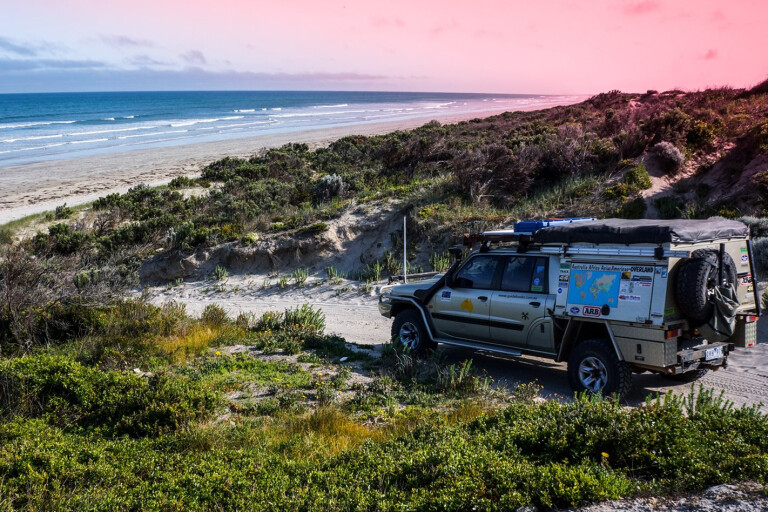
The sand, firm one minute and soft the next, forced us to make a hurried shift down through the gears to keep the forward momentum going and the engine in the power band.
We had already dropped the tyre pressures to 20psi, but after one long soft section we stopped on a short strip of firmer sand and dropped another few pounds – it’s incredible what a difference this can make.
We’d slipped onto the beach just north of Kingston SE in the south-east of South Australia, heading along the great arc of sand that stretches north to the Murray River mouth. We had already passed one access track at The Granites and were pushing on to the next, some 30km away, which was still more than 80km from the river mouth.
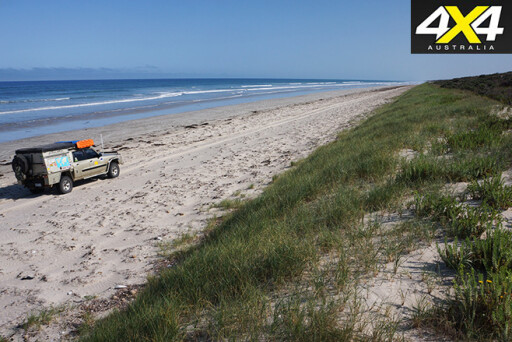 We’d checked with a couple of locals and knew the most northerly of the beach’s access tracks – Tea Tree Crossing – was still flooded with saline water, and we didn’t want to subject our Patrol to that rusting imposition, so we were going to get off the beach before then, but the choices were pretty limited.
We’d checked with a couple of locals and knew the most northerly of the beach’s access tracks – Tea Tree Crossing – was still flooded with saline water, and we didn’t want to subject our Patrol to that rusting imposition, so we were going to get off the beach before then, but the choices were pretty limited.
Continuing north, we soon arrived at the southern boundary of the Coorong National Park. Camping within the park is restricted to the beach between the high and low water marks and in designated spots behind the fore dune, marked by a wooden post. Once behind the dune, another post marks the centre spot of the camping area and you must park your vehicle within five metres of it. It’s all to do with minimising erosion of the fragile dunes, so do the right thing and we’ll still be allowed to camp in such a place for years to come.
 Access is closed north of Tea Tree Crossing between October 24 and December 24 each year to protect nesting seabirds, while a smaller area south of the river mouth is closed during ongoing sand-pumping operations to keep the mouth of the river open to the sea. There is no indication when this closure will be lifted, but hopefully it’ll happen when water flow increases.
Access is closed north of Tea Tree Crossing between October 24 and December 24 each year to protect nesting seabirds, while a smaller area south of the river mouth is closed during ongoing sand-pumping operations to keep the mouth of the river open to the sea. There is no indication when this closure will be lifted, but hopefully it’ll happen when water flow increases.
The going on this trip was slow, and as evening approached we took one of the rare access tracks that headed inland off the beach and went looking for a spot away from the wind to throw down the swag; it was the middle of spring but the southerly wind was bitingly cold.
The narrow lagoons of the Coorong, fringed by low tough scrub, are located behind the beach and the thin strip of bordering dunes of the Younghusband Peninsula.
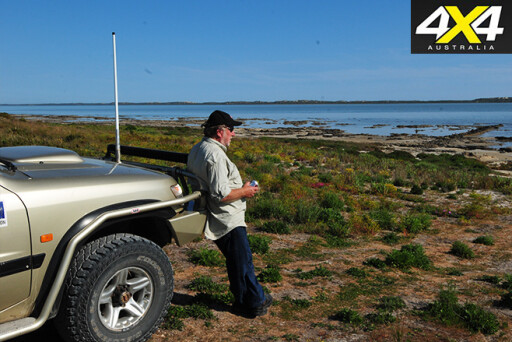 At the mouth of the Murray are a few low grassy islands that help separate the sea from the wide expanse of Lake Alexandrina and the smaller Lake Albert. A number of man-made barrages link the islands with the mainland north of the river mouth, and ensure that salt water doesn’t flood into the lakes but still flows into the lagoons of the Coorong.
At the mouth of the Murray are a few low grassy islands that help separate the sea from the wide expanse of Lake Alexandrina and the smaller Lake Albert. A number of man-made barrages link the islands with the mainland north of the river mouth, and ensure that salt water doesn’t flood into the lakes but still flows into the lagoons of the Coorong.
The local Ngarrindjeri people trace their heritage back 40,000 years; you’ll find the discarded heaps of shells at midden sites all along this wind-swept coast. Today, a number of small Aboriginal settlements and reserves are dotted around the lakes, inland from the Coorong, while a number of the locals act as guides or work as professional fishermen out on the lakes.
Charles Sturt was the first European to venture here, after he and his men sailed a whaleboat down the Murray River in 1830 – and then rowed it back upstream. Goolwa, on the northern and western sides of the river mouth, became Australia’s first inland port 10 years later, developing as a hub for the burgeoning paddle-steamer trade a few years later.
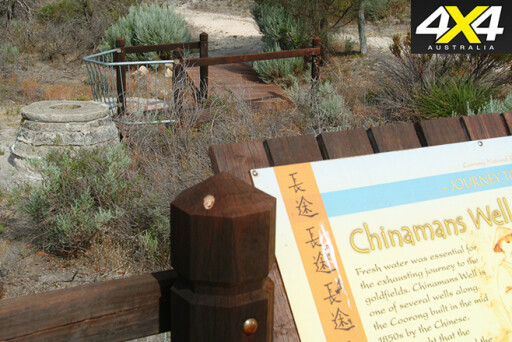 From about the time Adelaide was established in 1836, pioneers wandered the coast between Portland in Victoria and Encounter Bay, south of Adelaide. A stock route came about soon after, and then, during the late 1850s and early ’60s, a flood of hopeful gold seekers and Chinese immigrants walked along this coastal route to the goldfields of Victoria.
From about the time Adelaide was established in 1836, pioneers wandered the coast between Portland in Victoria and Encounter Bay, south of Adelaide. A stock route came about soon after, and then, during the late 1850s and early ’60s, a flood of hopeful gold seekers and Chinese immigrants walked along this coastal route to the goldfields of Victoria.
A Cobb & Co coach route was established and places including Woods Well, Salt Creek and Chinaman’s Well popped up to service the growing number of travellers; the route was the main land link between Melbourne and Adelaide for many years.
Pastoral development followed and the sea gave up its bounty of fish and other delights. Kingston SE was founded in 1860 and a few years later the first oil rig in Australia, operated by the Coorong Kerosene Company, set about searching for oil near Salt Creek. The oil search continued until 1933 and, while all the wells were unsuccessful, it established the oil industry in Australia that went on to bigger and better things.
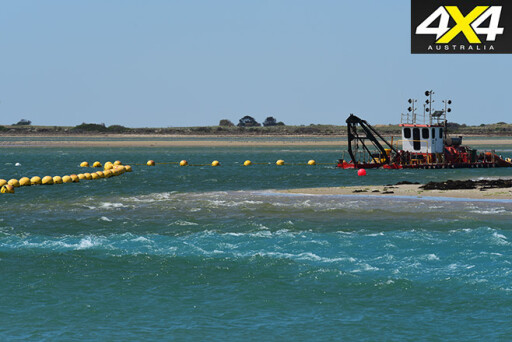 The Coorong National Park was established in 1966 and today protects 500km2 of coast, inland lagoons and dunes. Recreational fishermen and dune buggies have been making tracks along the sweep of sand since before the park was established, and more and more people now travel to the Coorong for the fishing, camping and four-wheel driving.
The Coorong National Park was established in 1966 and today protects 500km2 of coast, inland lagoons and dunes. Recreational fishermen and dune buggies have been making tracks along the sweep of sand since before the park was established, and more and more people now travel to the Coorong for the fishing, camping and four-wheel driving.
The region is extremely well-known for its prolific bird life, with more than 200 species recorded in the park; each year, many migratory birds arrive from distant lands. The small isolated islands of Coorong also act as Australia’s major breeding area for the impressive Australian pelican.
Being a well-protected section of water, the Coorong is popular with small boat owners, but the water is shallow and can get rough. Still, on a nice day it’s a great spot to paddle a kayak. The lagoons offer a feed of fish, with the northern section of the Coorong offering a bigger and better choice.
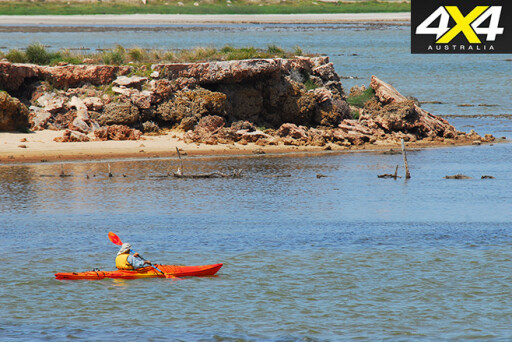 Mind you, in recent years an influx of New Zealand fur seals have invaded the lakes and munched on so many fish that the local mullet industry has almost closed down. The seals have also harassed the pelican colonies, so some people and politicians are now calling for a cull of the furry invaders.
Mind you, in recent years an influx of New Zealand fur seals have invaded the lakes and munched on so many fish that the local mullet industry has almost closed down. The seals have also harassed the pelican colonies, so some people and politicians are now calling for a cull of the furry invaders.
In pursuit of more birds – and to get away from the wind for a day – we headed inland and met up with the manager of the Watervalley Wetlands who showed us around this spectacular conservation property.
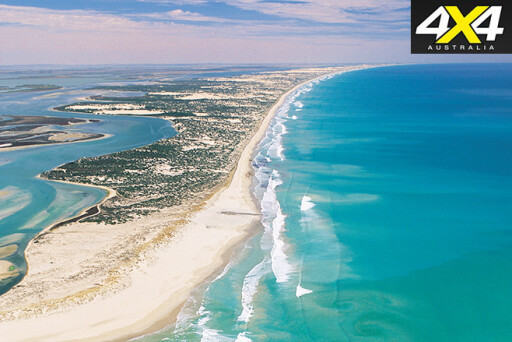 This privately funded conservation park covers 260km2 and is centred around a string of shallow lakes – Cortina and Mandena being the biggest – that parallel the coast about 10km inland. These lakes are classed as ‘ephemeral’, though they rarely dry completely.
This privately funded conservation park covers 260km2 and is centred around a string of shallow lakes – Cortina and Mandena being the biggest – that parallel the coast about 10km inland. These lakes are classed as ‘ephemeral’, though they rarely dry completely.
As such they play host to hundreds if not thousands of waterbirds, and on our short drive through part of the property we saw huge flocks of grey teal and large gatherings of black swans.
Located inland and to the south of the tiny settlement of Salt Creek, the string of properties can be reached via good dirt roads – more than 40km of four-wheel-drive tracks cut through the private park. These tracks are generally pretty easy for a 4WD vehicle, though at times there are some soft, sandy sections. Once farming land, much of the area has been revegetated and work continues to bring the country back to a more natural state.

There are two lots of accommodation: the shearer’s quarters and the old manager’s quarters. The shearer’s quarters sit on a hill overlooking a small string of lakes. Further north, the old manager’s quarters is located on top of one of the tallest vegetated dunes in the area.
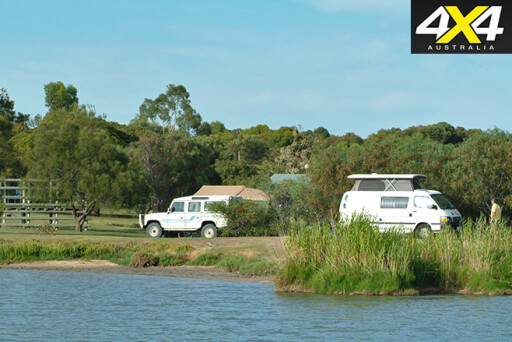 From the front verandah there are inspiring views westward over the calm waters of the Coorong, the dunes of the Younghusband Peninsula and the wilder waters of the Southern Ocean.
From the front verandah there are inspiring views westward over the calm waters of the Coorong, the dunes of the Younghusband Peninsula and the wilder waters of the Southern Ocean.
Wanting to get to the Murray Mouth after being stymied from accessing it from the south, we headed around the lakes, through Meningie, and took a quick detour to the only inland lighthouse in Australia.
Located on the historic Poltalloch Station, the light overlooks The Narrows between Lake Alexandrina and Lake Albert. Those with a bit more time can cross the stretch of water on a small ferry and head for Narrung and then trace Lake Albert back to Meningie, which is an enjoyable foray.
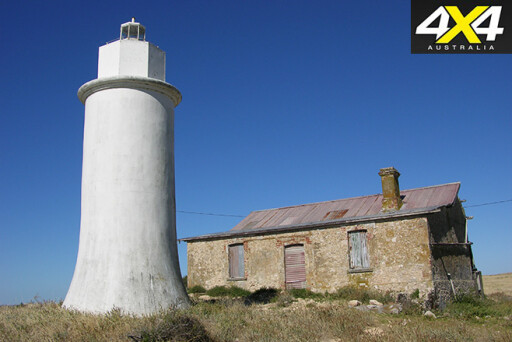 We took the ferry across the Murray River farther north at Wellington and dodged down through pleasant farming country to Goolwa, which is a bit of a holiday town these days, with coffee shops and surf stores. I grabbed a latte and headed out to the Surf Life Saving Club where a track cuts through the sand hills and onto the beach for the 10km run to the Murray River mouth.
We took the ferry across the Murray River farther north at Wellington and dodged down through pleasant farming country to Goolwa, which is a bit of a holiday town these days, with coffee shops and surf stores. I grabbed a latte and headed out to the Surf Life Saving Club where a track cuts through the sand hills and onto the beach for the 10km run to the Murray River mouth.
The beach was lightly dotted with 4WD vehicles, with most of the occupants standing patiently for their rods and reels to show some action, while others were just enjoying the beach and surf.
Closer to the Murray Mouth, a marked diversion takes vehicles around where a pipe spews sand across the beach from the nearby dredging operations that keeps the mouth open to the sea. This operation shifts up to a million cubic metres of sand each year and it’s treacherously soft sand, so don’t try and drive through it.
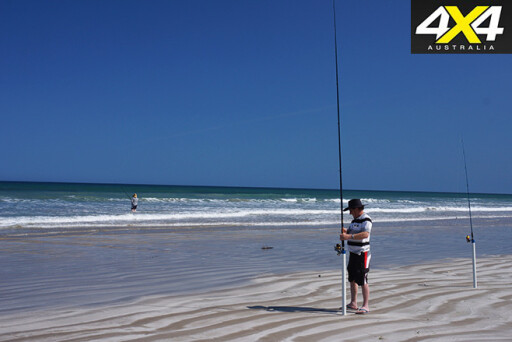 At the mouth itself, more fishermen were trying their luck, while others were boating, kiting, bird-watching or just enjoying the wide expanse of sand. No wonder the South Australians have always loved the Murray Mouth and the Coorong – you will too if you take the time to discover its secrets.
At the mouth itself, more fishermen were trying their luck, while others were boating, kiting, bird-watching or just enjoying the wide expanse of sand. No wonder the South Australians have always loved the Murray Mouth and the Coorong – you will too if you take the time to discover its secrets.
TRAVEL INFO
Located south-east of Adelaide, the Coorong can be reached via major highways either from Adelaide (three hours’ drive) or from Melbourne (seven-eight hours’ drive).
Kingston SE, Meningie and Goolwa have all the facilities a traveller requires.
The Salt Creek store and adjoining caravan park are the closest facilities to the more remote sections of the Coorong. The owner, Adam, knows the area well and can keep you up to date with the latest news regarding access: call (08) 8575 7021 to pick his brains.
The Watervalley Wetlands has a high population of bird and animal life, and also offers good camping, accommodation and four-wheel-drive trails. Get in touch via: www.watervalleywetlands.com.au.
Mundoo Island is a privately owned historic cattle station that takes up a couple of islands just inside the Murray Mouth. It’s a top spot for camping and has other accommodation options as well. See: www.mundooisland.com.au.
Poltalloch Station is a historic property skirting the edge of Lake Alexandrina. It offers cottage accommodation and historic tours and is well worth making the time to visit. See: www.poltalloch.com.au.
Camping permits are required for the Coorong National Park. These are only available online, so don’t leave home without one. See: www.environment.sa.gov.au.
Click here to explore more of South Australia.

COMMENTS